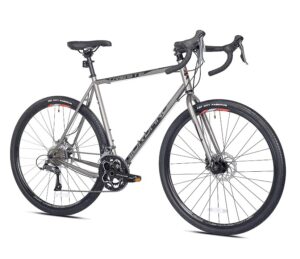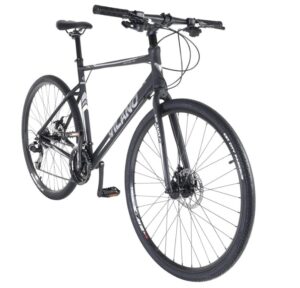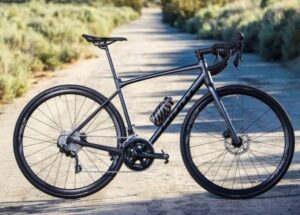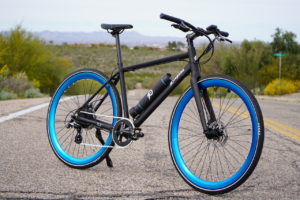Hybrid bike VS Road bike: A comparison Guide for beginners
 To the untrained eye, a road bike and hybrid bike may look indistinguishable. However, to someone who cycles regularly or is looking to purchase their first bicycle, there are several marked differences between the two.
To the untrained eye, a road bike and hybrid bike may look indistinguishable. However, to someone who cycles regularly or is looking to purchase their first bicycle, there are several marked differences between the two.
Most notably, road bikes tend to be lighter than hybrids and have narrower tires without treads. Additionally, while both types of bicycles typically come equipped with front and rear derailleurs and disc brakes;road bikes will generally have more gears than a hybrid.
Hybrids tend to use flat rather than lowered tires, and are often heavier than road bikes. Their shape provides a more upright riding position, and their saddles are cushion-like. In this piece, we’ll help explain the differences between a road bike and a hybrid, from big things to little things. Some of the differences are obvious, others not so much. But first of all, what are road bikes and hybrids really for?
Design
The best road bikes are designed for fast riding and quick handling on any pavement. For roads and bike paths, criterium trails and Pyrenean climbs, road bikes are best suited. Road bikes range from lightweight climbing bikes to aerodynamic racing machines and endurance-oriented frames. Road bikes have a wide range of off-road capabilities, but they are also limited to asphalt.
Read also:
Vilano Performance Hybrid Flat Bar Commuter Road Bike: Review
Best Road Bikes Under 1000 – Reviews And Ultimate Buyer’s Guide
The best hybrid bikes, on the other hand, are designed for mixed terrain, including asphalt and bike paths as well as soft gravel and light dirt. Their wide tires are more durable and puncture-resistant, but they are also much heavier than road bikes. Flat tires on a hybrid are very comfortable, but they lack aerodynamics and speed.
Hybrids made with the ability to fit wider tires, mudguards, headlights and trunks are often more appealing to novice cyclists and commuters who want to traverse more than just smooth sidewalks in a comfortable upright position.
How did hybrids appear?
Cyclists who like to go on long trips often choose highway bikes, but face a problem: it is difficult to overcome off-road. Road bikes are not at all adapted to riding on broken primers or gravel. That is why a bike with the advantages of MTB was created, while suitable for long and comfortable trips. The hybrid (another name for cross) is equally well suited for riding around the city and long tourist trips.
The main features of the hybrid:
- shock absorbing fork (options with rigid or short stroke are possible)
- massive wheels 28 inches
- installation of narrow tires
- tread that reduces rolling resistance
- the carriage is mounted low
- multi-speed transmission, oriented to speed
- saddle often with a shock absorbing pin, provides a comfortable fit
- frame, most often aluminum
All these differences give hybrids the following advantages: the ability to develop high speed when traveling on asphalt, good visibility, the ability to drive on moderate off-road. Most hybrid models are assembled on aluminum frames, which makes the bikes lightweight.
 If you plan to ride off-road more often, it is advisable to choose hybrid models with a shock absorber on the fork. For the development of high speed are responsible 28-inch wheels, with not wide tires. Treads are smooth or with small ground hooks, which reduces rolling resistance.
If you plan to ride off-road more often, it is advisable to choose hybrid models with a shock absorber on the fork. For the development of high speed are responsible 28-inch wheels, with not wide tires. Treads are smooth or with small ground hooks, which reduces rolling resistance.
Comfort on long trips is provided by a lightweight frame, well-thought-out geometry of the frame and handlebars, spring-loaded saddle. By the type of shock absorption and tires, hybrid bikes are distinguished by MTB and road.
MTB hybrid bike is assembled on a powerful frame, it is equipped with a shock absorber fork with a short stroke. The combination of 42 mm thick tires and tread with small lugs allows you to use the bike in different situations. The shock absorber effectively suppresses vibrations when riding on rough roads, and the transmission is quite enough to easily climb a hill.
Highway hybrids are assembled on a light frame, do not have a shock absorber, and are equipped with a straight steering wheel. Obviously, such models are poorly adapted for off-road.
Gears and brakes
There are a few areas where road bikes and hybrids have the most in common. One of these is in their use of similar technology for gears and brakes – with the latter being almost identical. However, when it comes to gearing, hybrids usually have a wider selection than road bikes do.
Hybrids are usually equipped with 2x or 3x gears, which means the number of front chainwheels. It is rare, though not impossible, to find a hybrid with 1x, although this configuration is still rare on most road bikes. Hybrids designed for beginners and hikers have a wide range of gears to make it as easy as possible to tackle hills.The smallest chain sprocket in the 3x package is often referred to as a “granny gear” because it is so small and easy to spin. However, the 3x circuit can be heavier and more difficult to set up and maintain compared to the 1x and 2x. Also, if you don’t ride steep hills often, the need for a “granny” gear is minimal.
 Road bikes most often have a two-speed gear with a “big ring” and a “small ring.” The most common scheme for road bikes is a 50/34t front chain with a 10- or 11-speed rear cassette. Rear gear in most cases ranges from 11t to 28t, while you can use a 30t or 32t gear when going uphill. On any bike, you’ll have a wide range of gears, whether you’re going up a steep hill or hurtling along at 50 km/h.
Road bikes most often have a two-speed gear with a “big ring” and a “small ring.” The most common scheme for road bikes is a 50/34t front chain with a 10- or 11-speed rear cassette. Rear gear in most cases ranges from 11t to 28t, while you can use a 30t or 32t gear when going uphill. On any bike, you’ll have a wide range of gears, whether you’re going up a steep hill or hurtling along at 50 km/h.
Both road bikes and hybrids are usually equipped with disc brakes, although there are many road bikes that still use rim brakes. Older type rim brakes are lighter, cheaper and easier to set up than disc brakes, although they are inferior in all respects. Disc brakes, both mechanical and hydraulic, are more powerful than rim brakes, work better in wet weather, and have some modulation, whereas rim brakes do not. In general, disc brakes work better than rim brakes.
Although disc brakes are generally more powerful, it’s vital to remember that rim brakes function and many cyclists prefer them for their aesthetics, lightness, and efficiency. Disc brakes are popular on modern hybrids, although you can still locate inexpensive models with rim brakes. Rim brakes are fine for everyday city riding. However, if you need superior performance or inclement weather protection, disc discs may be a good fit.
Frame Geometry
Hybrids are designed for everyday, upright riding comfort, and their frames reflect this. With a shorter top tube and shorter distance from the saddle to the handlebars compared to a road bike, the hybrid feels shorter and more upright than a road bike, not only in the feel of the ride, but also in the actual frame geometry.
The frame of a hybrid is designed so that most of the rider’s weight is on the saddle; whereas the frame of a road bike distributes the rider’s weight more evenly from the handlebars and front wheel to the saddle and rear wheel.
Road bikes are designed for high-speed riding, aided by a low and narrow aerodynamic position. The frame of a road bike has a longer top tube and a longer overhang compared to a hybrid, which results in a longer and lower seating position for the rider.
Wheels and tires
Both road bikes and hybrids use standard 700c road wheels to match their frames and create an optimal balance between speed, handling, and comfort. Some hybrids may have slightly larger or wider wheels and are designed for heavier off-road riding. Mountain bike wheels have the same feature: the extra size and width make them more durable and rugged on rough terrain.
 As for tires, road bikes use lighter, narrower and thinner tires than hybrids. This is all directly related to speed, as the best road bike tires are designed for the highest possible speed. With little tread – grooves and markings on the tire surface – road tires are fast on asphalt, but slippery on any off-road terrain.
As for tires, road bikes use lighter, narrower and thinner tires than hybrids. This is all directly related to speed, as the best road bike tires are designed for the highest possible speed. With little tread – grooves and markings on the tire surface – road tires are fast on asphalt, but slippery on any off-road terrain.
Most road tires range in width from 21mm to 38mm, with most cyclists opting for 25mm or 28mm wide tires. Road tires are much lighter and faster than hybrid tires, although they are much less durable. Hybrid tires are thicker, heavier, and wider than road tires, making them more puncture-proof. Most hybrid tires are over 32 mm wide, and tires as wide as 38 mm or even 40 mm fit most hybrid frames.
Hybrid tires have a wide range of treads, and you can choose one depending on the terrain you want. For urban commuting, slick hybrid tires or smooth treads would be the best option. But for hybrid cyclists who want to conquer off-road terrain a bit, they can choose a thicker hybrid tire with more tread overall and especially on the sides of the tire for slippery turns. Hybrid tires are heavy and slow compared to road tires, but they are also better on variable terrain, puncture resistant and better on wet roads.
Helm
One of the main distinctions between road bikes and hybrids is that road bikes have drop bars instead of flat bars. Drop bars are handlebars with a slight bend that provide three different hand positions for riders: on the hoods, on top, or in the drops. The hoods are located at the front of the handlebars–where you’ll also find brake and shift levers–and this tends to be the most comfortable position for riding on roads. Tops are typically used during climbs, while drops are utilized during descents, sprints and turns.
Hybrid bikes use flat grips that, like mountain bike handlebars, extend from left to right with a slight curve in the middle. Mountain bikes have only one hand position, and that is on both ends of the flat handlebars, but some hybrids have an extra detail on the handlebars called “bull horns.”These are curved extensions on the end of the flat rudder that can be used as a second arm position. This is a feature of hybrids that we don’t see on any other bike. Hybrids also use different brake shifter levers compared to road bikes-as you might have guessed, most hybrids borrow the style of shifting and brake levers from mountain bikes, since they both use flat tires of the same shape.
Instead of the vertical levers on road bike rosters, hybrids use thumb and finger shifters and separate levers for the brakes. Most road bike handlebars are between 38 and 44 cm wide, while hybrids have much wider handlebars, ranging from 52 to 70 cm.
Position
 As you may have guessed by now, there is a huge difference between the rider position on a road bike and on a hybrid bike.
As you may have guessed by now, there is a huge difference between the rider position on a road bike and on a hybrid bike.
Road bikes are built for speed and aerodynamics, which affects the rider position. You’ll be lower to the ground and your body will be more streamlined than on a hybrid bike.
This might put extra strain on your back and cause pressure in your arms and hands since you’re shifting your weight forward. Additionally, road bikes have a longer top tube that helps elongate the rider’s silhouette while still keeping them aerodynamic.}
Hybrid bikes are designed for casual and comfortable riding, which means a relaxed and upright position for the rider. Their upper tubes and stem are usually shorter than on road bikes, which helps the rider sit up while pedaling rather than leaning forward over the bottom bracket.
You also need a more balanced center of gravity on a hybrid if you’re going off-road on local trails or gravel roads, so the frame is designed to keep you upright and in control from a sitting position.
Accessories
Because they are designed to be lightweight and aerodynamic, road bikes don’t usually have a lot of extras. Most models, however, do have room for at least flashlights and water bottle cages.
This is nothing in comparison to hybrids, which often come with built-in mounts for accessories such as lights, trunks/panniers , mudguards , etc. The extra weight on hybrids doesn’t bother cyclists because these bikes are meant ole_hybridsbe ridden every day for commuting purposes.
Final Thoughts
When it comes to choosing between a road bike and a hybrid bike, there are many factors to consider. Both bikes have their own advantages and disadvantages, so it all depends on what your goals are as a cyclist. If you’re looking for speed, then a road bike is the way to go. However, if you’re looking for comfort, then a hybrid bike might be better suited for you.
Do you use that bike to commute to work in the rain or sun? Or do you want to break some records in a local time trial race, or compete for a few KOMs on the Strava? Hybrid bikes are all about feeling comfortable and confident on your bike on a variety of terrains. You won’t want to find yourself on a twisty singletrack, but your hybrid can definitely handle gravel, dirt and uneven asphalt. Wide tires help protect against punctures, and the upright position will help rest your back and arms.
Road bikes are much lighter and faster than hybrids, although they take some getting used to, both in terms of riding comfort and first-time use of gear/brake levers.
While you won’t be able to ride a road bike off-road, you’ll be much faster on it, whether it’s a group ride or a national championship. While a hybrid may be a better choice for commuting, a road bike will help you break personal records and ride faster than ever.